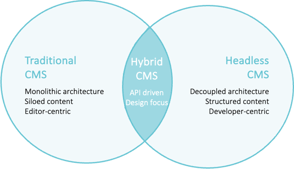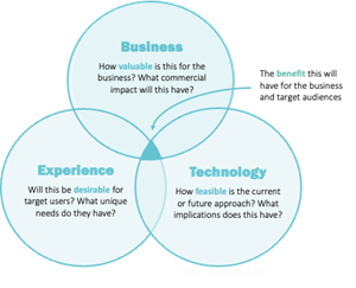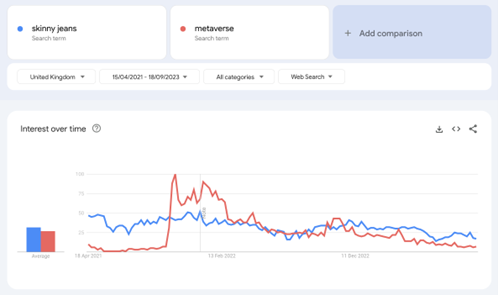.png)
1. Does it fit how you work?
Customers expect to be able to access content across a wide range of channels. This can be especially challenging for international brands serving multiple markets, with multiple languages, formats, and requirements to support.
To meet the rising demands of creating more integrated digital content experiences, many companies have switched to a headless content management approach with the of promise of greater flexibility, scalability, and more control over the front-end experience compared to a traditional CMS. However, with this flexibility comes additional demands on engineering, with front-end developers now fully in charge of content presentation and delivery. This is fine for companies with a dedicated development resource, but can result in longer lead-times, frustrated Marketing teams, or slower releases for the many companies who don’t have that luxury.
If you don’t have any plans to source, hire, or retain a front-end development team, a monolithic CMS with its own authoring environment and visual workflow is still a common choice, as it fits with established ways of working. While many are interested in the benefits of headless, it can often seem like too much of a commitment.
The good news is a third option is now available - the hybrid or composable CMS. This offers the best of both worlds, as it provides developers with the flexibility of including front-end components that are de-coupled from the CMS, but within a more traditional page paradigm which business users can use with low/no-code tools to control and manage content.

Figure 2 - Three main types of CMS platforms
There are more factors here to consider than just in-house FE team. SEO, security, publishing workflow needs etc.
2. Does it fit your future needs?
Improving operational efficiencies, customer experience, or developing new revenue streams are now driving IT investments - so it’s important to look beyond the technology when analysing current systems.
At DCX, we use our ‘BET Methodology’ to assess technologies from a commercial and customer perspective. This helps us translate user and stakeholder requirements into engaging experiences that deliver value for users, stakeholders, and shareholders.
It starts by understanding your digital business objectives and bench-marking the current state experience from different perspectives. This means when we audit any existing tools, platforms, or processes, we can assess the current capabilities of a solution against the pain-points identified in the experience stream, and the strategic goals or future direction of your business.

Figure 3 - Three main types of CMS platforms
Over half of companies report they are underutilising existing technology. Rather than thinking you need to rip up and replace everything, it’s worth looking for technologies or processes that are working well, such as design systems or reporting dashboards.
An inventory of existing tools used by different teams, regions, and local offices can also reveal what functionality to replicate when migrating to another system. Identifying useful tools or features that currently lack an API or connectivity with other systems can also be priority candidates for replacement.
Assessing current content streams also provides an insight into how well your content is structured and performing, so you can assess its suitability for re-use. Its commonly-assumed content, structure, or components, can be re-used when migrating or consolidating sites. However, moving to a hybrid or headless solution requires a content-first design approach, as you need a more structured content model to maximise potentially re-usability.
We normally review the outputs from a systems audit with you through a suite of co-creation workshops. We look at the ’as is' technology estate and current journey flows and then develop proto-journey maps of the ideal ‘future state’ experience. This ensures the desired technology approach is closely aligned with any desired changes in customer behaviour and supports the functionality required to deliver this level of change.
We should reference content-first-design principles when talking about headless.
3. Does it fit your budget or business case?
Having multiple CMSs means multiple workflows, with no easy way of sharing content or ideas between teams and rolling out updates or improvements. With no single source of code, designs or components, efforts become duplicated, releases take longer, brands become inconsistent, and experiences become fragmented.
Calculating the cost of doing nothing can be a useful exercise as it helps build momentum for change while providing a counter to any future business case. The consequences of sticking with the status quo can can be quantified using a simple formula:
- How many - the number of people affected
- How much - the duration or number of activities involved
- How often - the timeframe under consideration
For example, if two developers spend approximately 8 hours per week making routine front-end changes each month rather than using more customisable components...
2 developers (how many) x 8 hours (how much) x 4 weeks (how often) = 64 hours per month
This formula can also be applied to the time/costs associated with the manual processes, and duplication of efforts when managing content or maintaining systems. It could also include the lost FTEs from a system that's difficult to use, update or train new users on.
Cost calculations for other risks and issues are also available. For example, Gartner offers a detailed Downtime Cost Calculator whilst Microsoft has a tool for calculating the opportunity cost of process automation,
How to analyse your technology stack and make improvements
Digital technology choices affect your ability to compete or the operational efficiencies of your organisation in day-to-day activities.
Previously, the choice over which CMS to use rarely received much attention, as it was just a box where you put the website. Fast-forward to today and things are very different.
The decision over which CMS or architectural model to adopt is as much a question of organisational feasibility as it is a technical one. If the solution doesn't fit your ways of working then it's unlikely to deliver results, regardless of its technical excellence.
From our experience, there are no hard and fast rules about which platform fits the type of business. The devil is always in the detail, but these are unlikely to be met by choosing an off-the-shelf product.
You need a solution that is tailored to your organisation's needs, from a business, and technology perspective. Get in touch if you would like to know more about our six-step process for benchmarking current platforms and defining your future roadmap.



